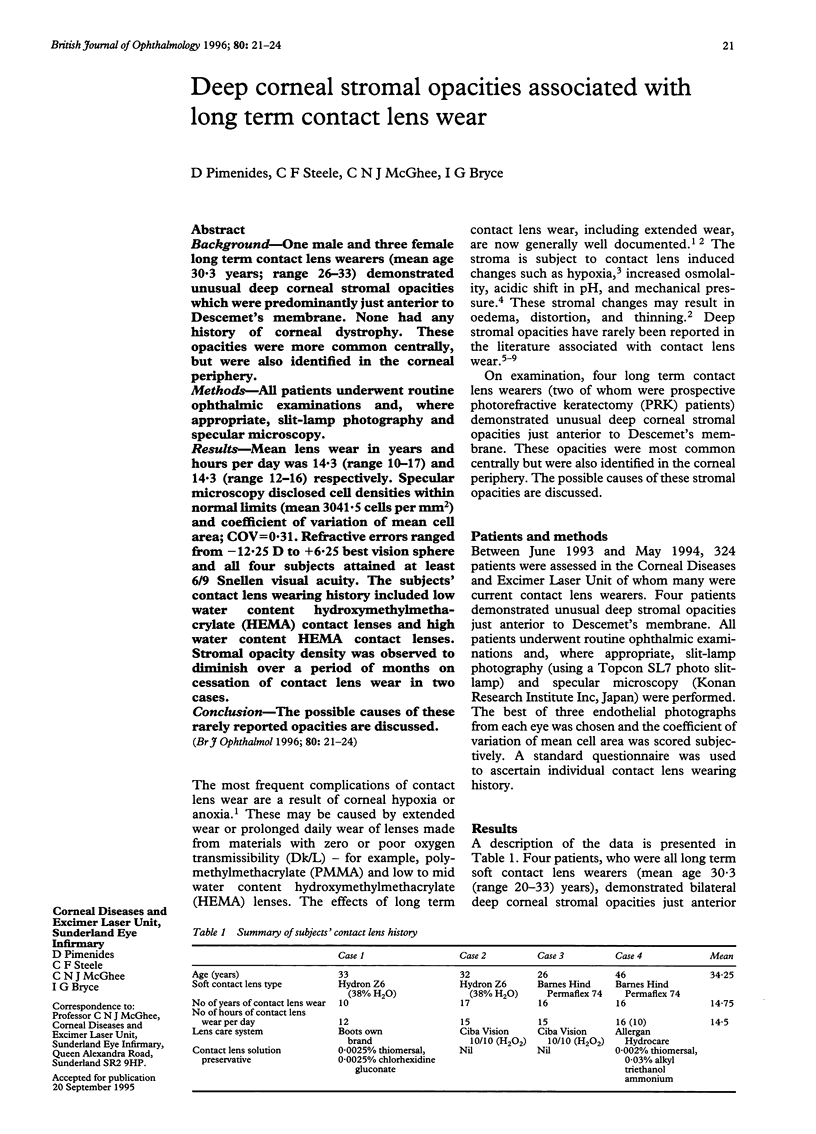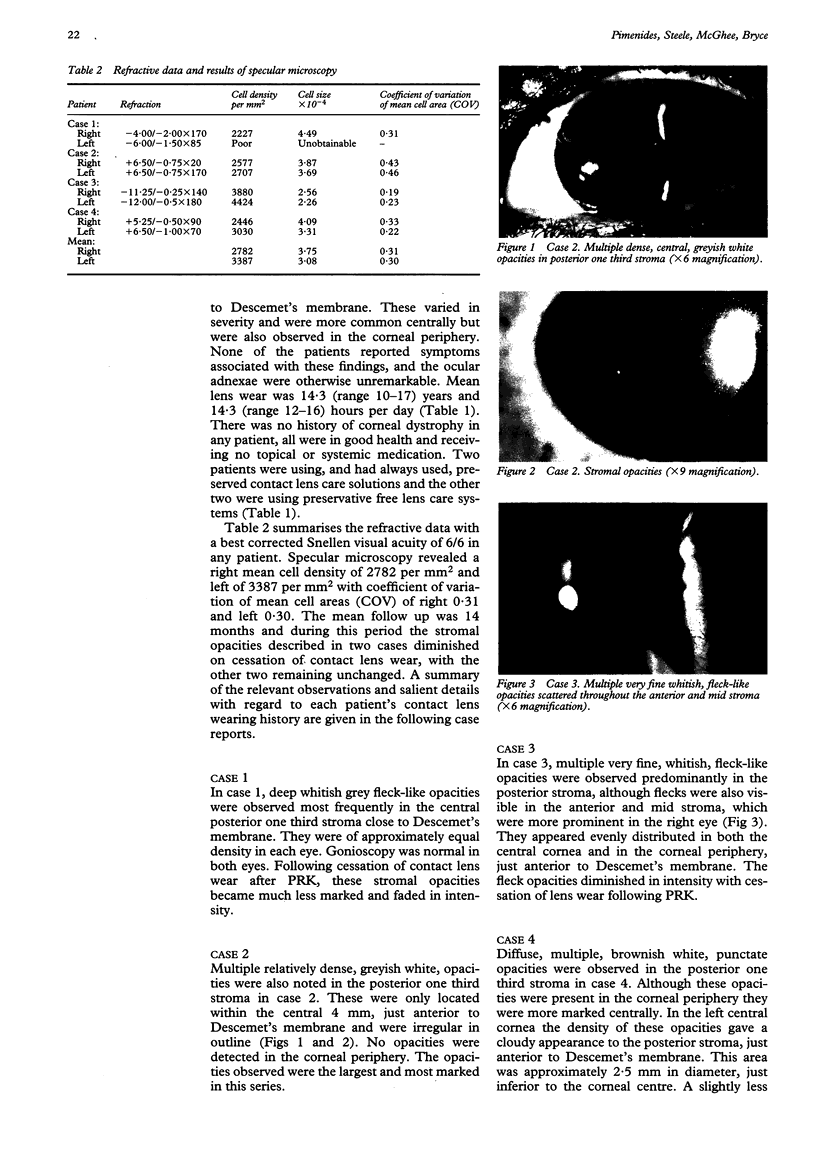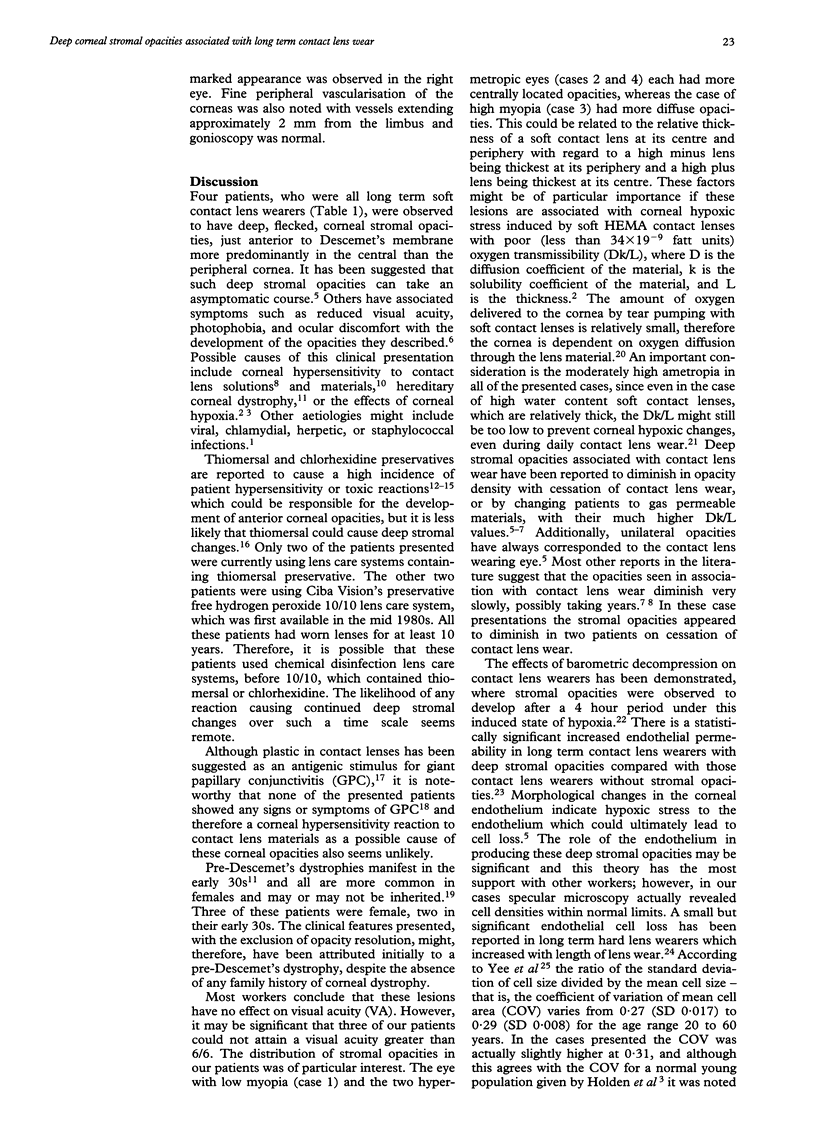Abstract
BACKGROUND: One male and three female long term contact lens wearers (mean age 30.3 years; range 26-33) demonstrated unusual deep corneal stromal opacities which were predominantly just anterior to Descemet's membrane. None had any history of corneal dystrophy. These opacities were more common centrally, but were also identified in the corneal periphery. METHODS: All patients underwent routine ophthalmic examinations and, where appropriate, slit-lamp photography and specular microscopy. RESULTS: Mean lens wear in years and hours per day was 14.3 (range 10-17) and 14.3 (range 12-16) respectively. Specular microscopy disclosed cell densities within normal limits (mean 3041.5 cells per mm2) and coefficient of variation of mean cell area; COV = 0.31. Refractive errors ranged from -12.25 D to +6.25 best vision sphere and all four subjects attained at least 6/9 Snellen visual acuity. The subjects' contact lens wearing history included low water content hydroxymethylmethacrylate (HEMA) contact lenses and high water content HEMA contact lenses. Stromal opacity density was observed to diminish over a period of months on cessation of contact lens wear in two cases. CONCLUSION: The possible causes of these rarely reported opacities are discussed.
Full text
PDF



Images in this article
Selected References
These references are in PubMed. This may not be the complete list of references from this article.
- Allansmith M. R., Korb D. R., Greiner J. V., Henriquez A. S., Simon M. A., Finnemore V. M. Giant papillary conjunctivitis in contact lens wearers. Am J Ophthalmol. 1977 May;83(5):697–708. doi: 10.1016/0002-9394(77)90137-4. [DOI] [PubMed] [Google Scholar]
- Brooks A. M., Grant G., Westmore R., Robertson I. F. Deep corneal stromal opacities with contact lenses. Aust N Z J Ophthalmol. 1986 Aug;14(3):243–249. doi: 10.1111/j.1442-9071.1986.tb00043.x. [DOI] [PubMed] [Google Scholar]
- Caldwell D. R., Kastl P. R., Dabezies O. H., Miller K. R., Hawk T. J. The effect of long-term hard lens wear on corneal endothelium. Contact Intraocul Lens Med J. 1982 Apr-Jun;8(2):87–91. [PubMed] [Google Scholar]
- Castrén J., Tuovinen E., Länsimies E., Stenborg T., Aho J., Nedrum K. Contact lenses in hypoxia. Acta Ophthalmol (Copenh) 1985 Aug;63(4):439–442. doi: 10.1111/j.1755-3768.1985.tb01560.x. [DOI] [PubMed] [Google Scholar]
- Grayson M., Wilbrandt H. Pre-descemet dystrophy. Am J Ophthalmol. 1967 Aug;64(2):276–282. doi: 10.1016/0002-9394(67)92524-x. [DOI] [PubMed] [Google Scholar]
- Green K., Livingston V., Bowman K., Hull D. S. Chlorhexidine effects on corneal epithelium and endothelium. Arch Ophthalmol. 1980 Jul;98(7):1273–1278. doi: 10.1001/archopht.1980.01020040125020. [DOI] [PubMed] [Google Scholar]
- Göbbels M., Wähning A., Spitznas M. Endothelfunktion bei kontaktlinsenbedingten tiefen Hornhauttrübungen. Fortschr Ophthalmol. 1989;86(5):448–450. [PubMed] [Google Scholar]
- Holden B. A. Perspectives on the future of contact lens wear: summary. Cornea. 1990;9 (Suppl 1):S69–S71. doi: 10.1097/00003226-199010001-00028. [DOI] [PubMed] [Google Scholar]
- Holden B. A., Sweeney D. F., Vannas A., Nilsson K. T., Efron N. Effects of long-term extended contact lens wear on the human cornea. Invest Ophthalmol Vis Sci. 1985 Nov;26(11):1489–1501. [PubMed] [Google Scholar]
- Holden B. A. The Glenn A. Fry Award lecture 1988: the ocular response to contact lens wear. Optom Vis Sci. 1989 Nov;66(11):717–733. [PubMed] [Google Scholar]
- Kilp H., Konen W., Zschausch B., Lemmen K. Tiefe und hartnäckige Hornhautparenchymschäden nach Kontaktlinsen und ihr Verlauf. Fortschr Ophthalmol. 1982;79(2):116–117. [PubMed] [Google Scholar]
- Mondino B. J., Groden L. R. Conjunctival hyperemia and corneal infiltrates with chemically disinfected soft contact lenses. Arch Ophthalmol. 1980 Oct;98(10):1767–1770. doi: 10.1001/archopht.1980.01020040619005. [DOI] [PubMed] [Google Scholar]
- Pinckers A., Eggink F., Aandekerk A. L., van 't Pad Bosch A. Contact lens-induced pseudo-dystrophy of the cornea? Doc Ophthalmol. 1987 Apr;65(4):433–437. doi: 10.1007/BF00143046. [DOI] [PubMed] [Google Scholar]
- Polse K. A. Tear flow under hydrogel contact lenses. Invest Ophthalmol Vis Sci. 1979 Apr;18(4):409–413. [PubMed] [Google Scholar]
- Remeijer L., van Rij G., Beekhuis W. H., Polak B. C., van Nes J. Deep corneal stromal opacities in long-term contact lens wear. Ophthalmology. 1990 Mar;97(3):281–285. doi: 10.1016/s0161-6420(90)32591-5. [DOI] [PubMed] [Google Scholar]
- Rietschel R. L., Wilson L. A. Ocular inflammation in patients using soft contact lenses. Arch Dermatol. 1982 Mar;118(3):147–149. [PubMed] [Google Scholar]
- Van Horn D. L., Edelhauser H. F., Prodanovich G., Eiferman R., Pederson H. F. Effect of the ophthalmic preservative thimerosal on rabbit and human corneal endothelium. Invest Ophthalmol Vis Sci. 1977 Apr;16(4):273–280. [PubMed] [Google Scholar]
- Wilson-Holt N., Dart J. K. Thiomersal keratoconjunctivitis, frequency, clinical spectrum and diagnosis. Eye (Lond) 1989;3(Pt 5):581–587. doi: 10.1038/eye.1989.91. [DOI] [PubMed] [Google Scholar]
- Wilson L. A., McNatt J., Reitschel R. Delayed hypersensitivity to thimerosal in soft contact lens wearers. Ophthalmology. 1981 Aug;88(8):804–809. doi: 10.1016/s0161-6420(81)34945-8. [DOI] [PubMed] [Google Scholar]
- Yee R. W., Matsuda M., Schultz R. O., Edelhauser H. F. Changes in the normal corneal endothelial cellular pattern as a function of age. Curr Eye Res. 1985 Jun;4(6):671–678. doi: 10.3109/02713688509017661. [DOI] [PubMed] [Google Scholar]





